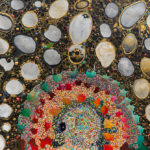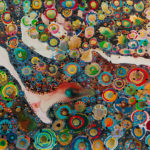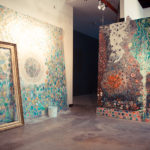Writer Lara Piu
Photography Bryan Black and John Dowd of Clutch Photos
[dropcap]A[/dropcap] picture tells a thousand words, but for artist IdaKatherine Graver, it is a thousand dots that tell a life story.
After quietly working in the background for the last four years, she’s re-emerged in the public eye with her new acrylic-on-wood fine art collection, “One Lived Life.”
“Things feel ready,” IdaKatherine says. “When I moved the pieces out of this studio world, I could hear one say, ‘I’m so glad to be leaving this room.’”
Each piece tells the story of a person’s journey through IdaKatherine’s unique means — layers upon layers of dots. She meticulously places them alongside other painted shapes; it’s her way of making sense of the world.
“I’m always looking for why are we here,” IdaKatherine says. “I need there to be meaning in life. I’m not comfortable without meaning.”
In February she unveiled “One Lived Life” in the Studios at Bentley Projects exhibition area, where she also has a working space. She moved into the approximately 350-square-foot vaulted celling art studio in April 2014 to create larger-than-life pieces for the series. Today, some of her pieces measure up to 8-feet by 8-feet. Many of them took more than six months to create. So far, there are six in the new series, which IdaKatherine says is a taste of what’s to come.
She creates the dots by laying wood planks flat on sawhorses. This allows her to drop each dot with precise intention.
“Dots, to me, are a way of looking at time and space, so it’s always like a moment or a time,” she says, explaining the meaning behind the colors. “Color is my mother tongue. The golden ones are a more abundant, joyful, peaceful moment, and the dark ones are more of an effort, the unknown, and the difficult. I don’t really have a science for it, but it’s my language.”
Each piece in the series depicts the good, the bad and the ugly of life, and IdaKatherine’s interpretation is magical. Stories of happy lives, difficult ones and even the life of Emily Dickinson are told.
The bottom of each painting represents the conditions a person was born into; the mid section represents the person; and everything upward and outward from that is the person’s interaction with the universe.
IdaKatherine explains, “I feel like everything we do creates something unseen,” she says. “In America we’re moving so fast that we’re not feeling that anymore. I think that everything that someone does makes part of the universe.”
In one piece, “A Well Lived Life,” she follows a life born unto fertile ground, community, health and abundance. In this piece, the subject has made the most of their time on earth, she explains. “They’ve had a lot of good fortune and they’ve created something that looks something like this.”
Framed in a gold altar-like structure is “Lucas,” a darker story. It walks through the life of IdaKatherine’s oldest son’s best friend. He was someone they loved very much who was hard-hit by mental illness.
“He was so golden, and all of a sudden it was taken away,” she remembers. “Because of his circumstances, he knew people from all over the world, but as he was sick, people pulled away because they were not comfortable with [his mental illness]. I think his world got quite small.”
Although his life ended in suicide, the piece shows how Lucas had a tremendous impact.
“When he died, he had the most amazing service. People came from all over the world. [The service] took 10 hours. I’ve seen a great change in the world as a result of his death; his essence spread over many people.”
Another story of struggle is told in “A Refugee from Aleppo,” I which IdaKatherine paints a person living in the war-torn country. At the bottom is the beautiful Arab culture, and their good and not-so-good ideas, she explains.
It tells the story of the Sunni, the Shia and the individual, and their effort to survive. “It’s still quite a beautiful life,” she explains. “I feel like we should be celebrating the courage of the people of Aleppo.”
The “One Lived Life” collection is perhaps a natural succession to IdaKatherine’s earlier series, “Heaven and Earth,” “Divine Anatomy” and “The Way Things Work,” which also explore life and living themes.
“I’m always wanting to make sense of things from a distance, although I cannot understand them right now. There’s kind of a motion. I think over time things are better. It’s slow, but I feel like it’s working toward better. “
IdaKatherine has first-hand experience with generational improvements. Her mother, also a brilliant artist, struggled greatly to find artist peers, but IdaKatherine was able to trade babysitting time with neighborhood moms, which allowed her to be an artist and raise her and her husband’s three sons.
“That was a big blessing,” IdaKatherine says.
In fact, both of her parents were formally trained artists; her father attended Cranbrook Academy of Art in Michigan and her mother attended Pratt Institute’s School of Art in New York. After graduating, her parents moved to southeastern Texas where they created a spacious art studio and foundry. They rubbed off on IdaKatherine, who’s been painting since near-birth. Her father has a cast of her first piece, a fish she drew in the sand at 18 months old. He made canvas her childhood toy.
“When we were bored, he would say, “Oh! Well, I will set up a still life and you can do contour drawing,” she jokes. “We didn’t take many vacations, but when we did, we went to museums.”
As an adult, IdaKatherine desired a more typical life and considered becoming a banker, but like the dots in her paintings, her life choices were intentional, resulting in the path she’s on today.
“I’ve never made one single decision that would let me be a banker. Not one.”










Comments by Admin